But India is not defined by the magnificent tomb of Mumtaz Mahal, the emperor's wife. In fact, it is so large a country, with such a huge and diverse population, a myriad of languages, religions and philosophies, that it would be impossible to say any one thing could possibly define it.
Typical diversity is to be found at our first stop, the port city of Cochin, located on the southwestern coast of India on the Arabian Sea. Cultural influences here include those of the Dutch, Portuguese, Chinese, Arabs, and British- and one glaring anomaly- the settlement known as Jew Town.
There are few places in the world where Jews have been permitted to live for extended periods of time. Usually, a change of rulers was accompanied by an order to kill and/or expel Jews. Here, however, Jews were welcome and they built a modest house of worship, the Paradesi Synagogue.
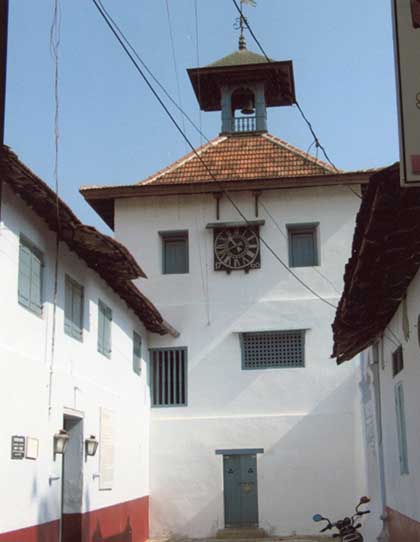
The synagogue itself was constructed in 1568, and has been in continuous use since then. The clock tower was added in 1760. It has been rated as the oldest synagogue in all the 53 member-countries of the Commonwealth of Nations.
Another noted House of Worship: Depending on whom you believe, this church is the final resting place of the famous Portuguese explorer, Vasco da Gama. He left Portugal in August 1498 and arrive the next year in India (on a ship not quite as nice as the one we arrived on!)
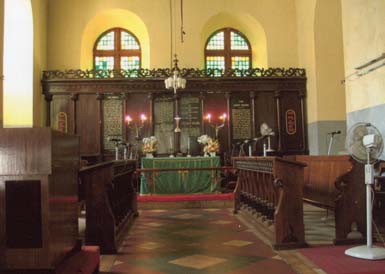
He returned home to Portugal, but was sent back to India in 1524 to deal with the mounting corruption among Portuguese authorities there. Arriving in Cochin, he fell ill and died on 24 December 1524. Local authorities dispute the claim that In 1539, his body was taken back to Portugal and re- buried.
Walking along the shoreline, you cannot help but see strange structures whose use is not immediately apparent. These are the famous Chinese fishing nets, found only in this area of India.

The weighted stones in the far left of the photo make it easy to lift up the netting. Making these nets was learned from the Chinese centuries ago, and is responsible for the large fishing industry that exists in Cochin today.
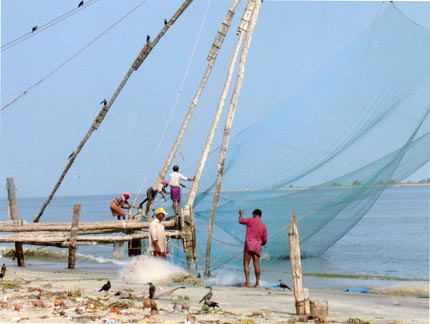
Construction, while crude, is quite effective. allowing the men to manually haul the nets and reap their rewards.
Those not financially able to make the Chinese nets will make these small boats instead.

These are hewed from local timber and shaped by hand. The men will go out to sea alone, sometimes with another fisherman, and catch what they can. There is a large local fish market, but we see perhaps a hundred of these little craft. So as you can imagine, competition is great and the daily take home pay of the fishermen is small.
******************
From Cochin, we flew to Delhi, arriving on schedule at 7PM. The airlines had mis- handled our wheelchair and had bent one of the rear wheels. This caused a two hour delay while the mechanical crew repaired it, but by the time they finished, I was exhausted and in a really foul mood.
Our guide for the next few days, Nikhil, told us this was our Karma- that something good would result from this inconvenience and delay. I'm afraid my bad mood prevented me from "hearing" anything he had to say.
Yet, it turned out to be as he said it would. We arrived at our hotel just as a traditional Indian "street wedding" was beginning. There are colored lanterns, fireworks, and quite a large marching band playing gaily as our van approached the hotel.

Nikhil explained that ordinarily In these weddings, the groom travels from his home on a white horse - never black - through the public streets to the bride's house, where the wedding would be held. Usually, this follows several days of pre-wedding celebrating. In this case, the wedding party was apparently too large and the decision was made to hold it at the best hotel in Delhi.
Nikhil tells us how fortunate we are to witness this event, as it has become so expensive that only a very few fathers can afford to foot the bill for such weddings anymore. Judging by the size of the band, the extent of the fireworks, and the number of participants, this must be one VERY rich papa, indeed! We are invited to join the party, and we are given lovely, heavenly smelling flower leis.
Just when you would have thought nothing else could make this event even more joyful, the bride appears!

Nikhil tells us it is traditional for Indian fathers to give their daughters the most elaborate wedding humanly possible. To do so not only brings great happiness to the bride and groom, it also earns "marks of good behavior" for the father. These "marks" will be used to help obtain a good place for the father in the next life- or incarnation. In this case, we suppose this dad will be reincarnated as a maharaja!
Now really exhausted, but excited, we leave the wedding party and check into the hotel, wearing our flower leis.

We are told that the red and white flowers denote male and female, and these are strung together as a symbol of unity, or marriage.
***************************
The next morning, we are a little hung over from the excitement of the wedding, but it is time to move on from Delhi to our ultimate destination in India. We check out of the hotel and drive to the airport for the flight to Agra, the location of the Taj Mahal.
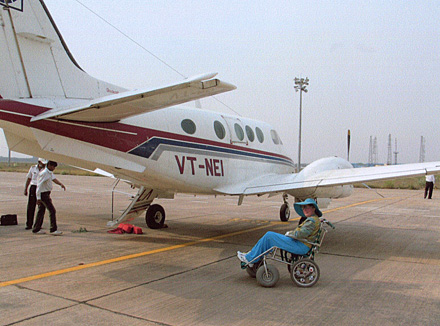
At the time, Nancy was still able to walk a few stairs, and several crew members help me get her aboard. We are both quite excited by the prospect of what is ahead- the fulfillment of another dream!
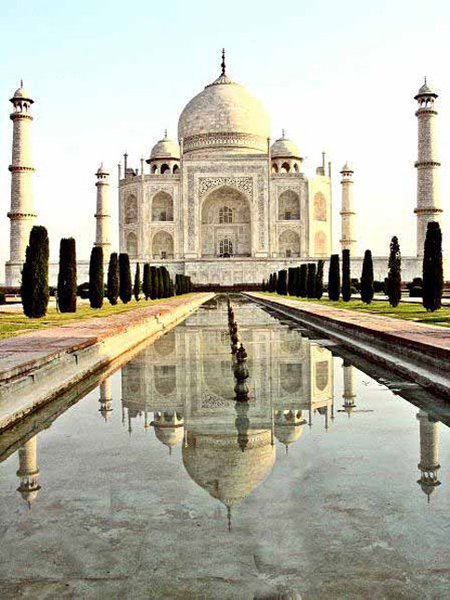
Like many famous works of art, the Taj Mahal looks different depending on the time of day, the weather, the angle of view. This picture was taken fairly early in the morning, and the marble appears with a yellow glow. Later in the day, it will appear as pure white.
The photo is also taken on our second day of visiting, a "classic" view of the Taj, capturing the mirror image of the structure in the pool of water in front of it. The day before, the pools were empty for cleaning. Our guide, who had been the escort of President and Mrs. Clinton, persuaded the groundskeepers to refill the pool specifically so we could get this shot.
Here is an entirely different and seldom seen view of the Taj Mahal- taken from the room at Agra Fort where Shah Jahan was imprisoned by his son. Every day he would gaze across the river at the tomb he built for his adored wife, until he finally died, 8 years later, of heartbreak.
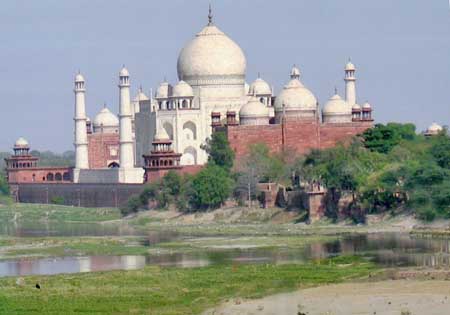
The river had more water in it in his time. The landscape was lusher along its banks. But we must count ourselves fortunate because the land you see in the foreground is land a developer wanted to fill in and build a shopping mall- just a mere 50 yards away. Thank Goodness he failed!
*******************************************************
The Taj Mahal is not a single building, but an extensive complex containing gardens, two gatehouses, the tomb, two mosques (for symmetry), four minarets, numerous bells and minor structures.
FYI: "Taj" means crown or diadem; "Mahal" means palace or mansion. The edifice cost 40 million rupees at the time when 1 gram of gold equaled 1.3 rupees. Any way you do the math, it was an expensive undertaking!
Having come so far to see it, we must go in to appreciate the delicate beauty of the design and decoration. While Nikki and Nancy sleep (not together, of course), Raj takes me back to the Taj Mahal. We arrive just before sunrise, and it is pleasantly cool and nearly free of tourists.

Remembering this is a tomb- and out of respect for the husband and wife buried here, I take no pictures inside the mausoleum itself. But getting inside is not easy for someone in a wheelchair!
First, we must remove our shoes and rent slippers. Assured that Nancy is not going to get out of the wheelchair, the attendants let her keep her shoes on.
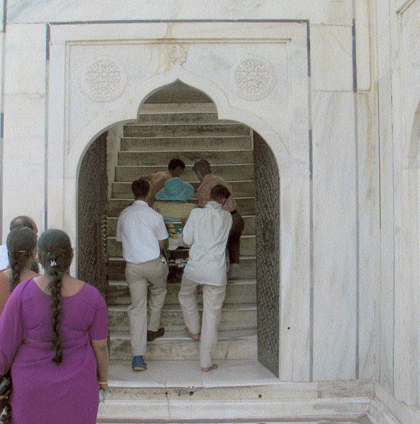
Aah, where is the Americans With Disabilities Act when you need it? We hire two local fellows who will remain with us throughout our visit to the Taj. Here, they, along with Nikhil and Raj, our specialist guide, carry Nancy up the steep stairs to the landing above where the entrance to the mausoleum is located. Not seen in this picture, there are perhaps 100 people behind me watching Nancy. It is rare to see someone in a wheelchair at this monument. Indeed, there are NO other wheelchairs to be seen this afternoon- or any time during our three days at the Taj Mahal. Pity.
**************************************
You would expect the interior to be as lovely as the exterior-= and it is. Remember- you are not looking at plaster molding, but carvings in marble.
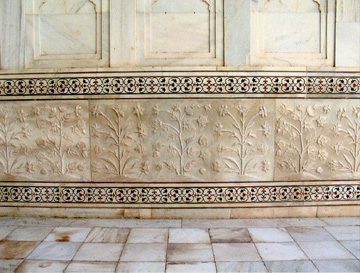
There is also no end of pieces of colored marble, cut and then precisely fit to make stunning displays. Just as I am getting ready, a shaft of light strikes a section of the decoration, highlighting the ultra-sharp contrast of the complexity of the design.

The large flower just to the right of center consists of 125 different pieces of colored stone, flawlessly assembled to produce this small piece of artwork. There are thousands of such works throughout the temple.
Raj arranges a tour for us at a "factory" where these decorations are produced. Many of the craftsmen working here can trace their lineage directly back to the men who worked on the construction of the Taj Mahal.
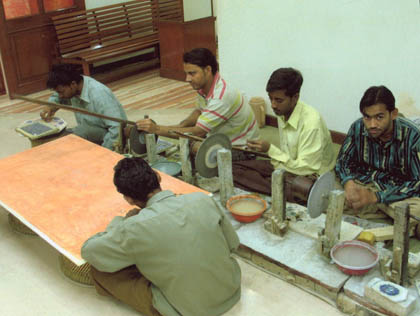
The fellow in the red striped shirt uses a wooden rod with a leather thong attached to turn the set of wheels used to polish the cut stones.
There are a number of different styles and techniques used to create these art pieces. Here is a fine example where spaces are intentionally left between the cut stones.

After each piece of stone is placed, then a filler material can be used. Here, the filler is used to create the illusion of stems and emphasizes the individual petals of the flowers.
A final bit of history:
In 1612, Mumtaz Mahal was married to Shah Jahan, the fifth Mughal emperor. She was her husband's inseparable companion, comrade and counselor. She bore him fourteen children and died in childbirth in 1630. Overpowered by grief, Shah Jahan was determined to perpetuate her memory for immortality and decided to build his beloved wife the finest sepulcre ever- a monument of eternal love.
His efforts have become world famous for the architectural magnificence and aesthetic beauty. It has always been included as one of the foremost wonders of the world since its construction. As a tomb, it has no match on earth.
The site was chosen because it was located on a bend in the river and could be seen from Shah Jahan's personal palace in Agra Fort, just a little upstream. The most skilled architects, inlay craftsmen, calligraphers, stone- carvers and masons came from all over India and lands as distant as Persia and Turkey to build it. Material was brought in from all over India and central Asia,. and it took a fleet of 1000 elephants to transport it to the site. After twenty two years, and the combined effort of over twenty thousand workmen, the complex was finally completed in 1648.
************************************************
Shah Jahan had three sons, the third named Aurangzeb. Though younger than his two brothers, he was by far their superior in competence and character. He challenged the rule of his father and the succession of his older brothers. There was a fight, and he was eventually victorious in battles that occurred between him and the other brothers. In July 1658, he ascended the throne.
One of his first acts was to imprison his father at Fort Agra. The room was covered in royal tapestries, the floors covered in expensive carpets. There was a fountain in the middle of the room that flowed continuously, and there was a full compliment of servants to attend to his father's needs.
Cruelly, the windows of the suite overlooked the Taj Mahal, and Shah Jahan, forbidden to leave his rooms, lived there, looking at his cherished wife's tomb, for eight years until his own death.
When he died, in a merciful gesture, Aurangzeb placed his father's remains beside those of his beloved wife inside the Taj.
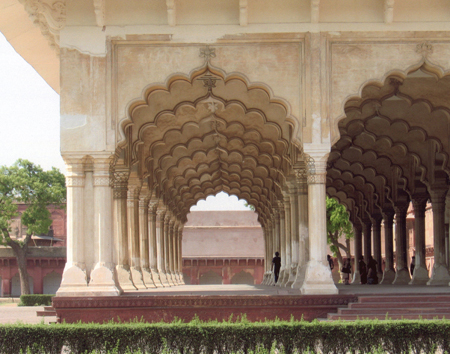
This is the entrance to Agra Fort and the emperor's palace. It is a perfect example of the type of symmetry typical of the architecture used at the Taj. While obviously massive, the feeling at its steps is light, airy, cool, and inviting.
************************************************
We will finish our tour of Agra and the Taj Mahal with this photograph of a flat wall plaque. Thousands of tiny pieces have been cut, polished and fitted to produce this stunning rendition.
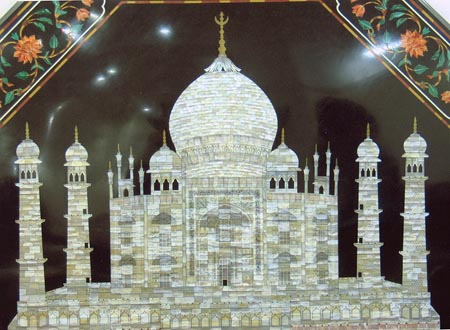
The work is so cleverly designed, in terms of selection of the colored pieces of marble, that if you allow your vision to "drift" just slightly, it almost appears three dimensional.
If you are really a sharp observer, you will note the four minarets appear to be leaning outward. This is actually the case in the Taj Mahal itself. The minarets were designed this way so in the event of an earthquake, they would fall away- and not cause damage to the main building itself.
********************************************
Time to move on, this time to Mumbai (Bombay), where I have made elaborate surprise plans for Nancy. Years ago when our children were small, we took them to the Universal Studios Tour in California. They loved the show- but nowhere near as much as Nancy did. She was like a ten-year-old kid and had the time of her life. So we went to Mumbai so she could experience a full tour of Bollywood.
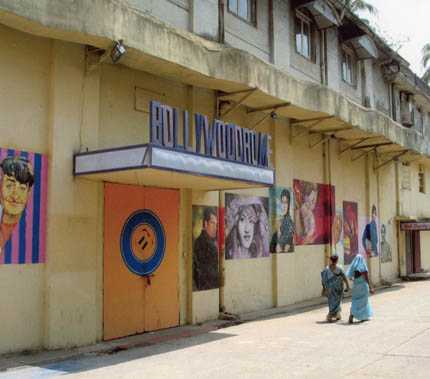
This is the Indian film capitol, Hollywood on steroids. The industry is concentrated in Mumbai, but its elements are scattered all over the vast city. The studios are in one quadrant, the costume
departments in another quadrant, post production in yet a different quadrant, so lots of driving is required if you want to see all of it.
Not even on the worst day in Rome, legendary for its traffic jams and impatient drivers, have we experienced traffic like it is in India. It’s as though millions and
millions of Indians have cars- and all of them were going exactly where we were going, at exactly the same time, but all of them were already late! Congestion to the MAX. Weaving in and out, making their own
lanes, driving on sidewalks, horns honking incessantly. Not even New York City could touch it.
Leaving traffic behind, our first studio stop was for wardrobe.
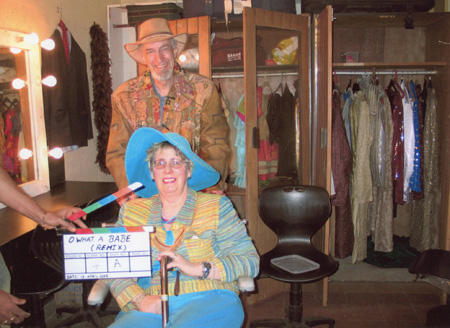
You can tell by the look on her face she is going to have a fantastic time! This particular studio supplies costumes and sets for many of the other independent studios. Here, I try on a jacket custom made for the star of the Action-Western-Musical "O, What a Babe". It was widely released (in India) several years ago. The hat is my own African safari hat, which the wardrobe people thought was perfect for the part!
Next, it is Nancy's turn to get the Bollywood Treatment. They have an exotic part in a blockbuster in mind for her.

The director is trying to cast someone for a remake of a Fred Astaire- Ginger Rogers movie, and this room has been used as a ballroom for earlier knock offs of the Rogers/Astaire films. Unfortunately, Nancy is not quite correct for the dance sequences.
He decides to use her in another film he is shooting about Mexican drug cartels. Frightened, alone, suspected of dealing drugs, " Nanicita" languishes in a Mexican prison cell awaiting torture- or worse...

In this next scene, she is being rescued by her compatriots, and as you can see, the door to the cell has been unlocked. ACTION!
************************************
Our "tour" included a visit to the set where they were shooting the Indian version of a typical soap opera. These are enormously popular in India, and I thought Nancy, who has watched As the World Turns since she was a teenager and Days of Our Lives for nearly 45 years, would really get a kick out of it.
They were filming a scene where one of the heroes was in the hospital, dying (almost) from gunshot wounds.
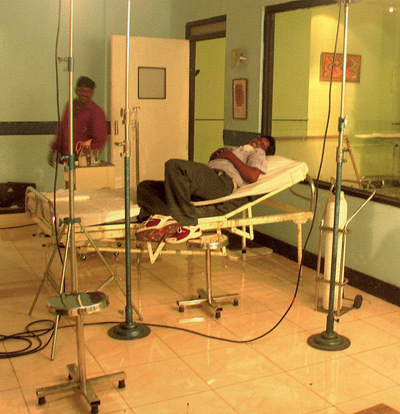
Nancy, in her wheelchair, fits right into the hospital scene. Though not in this sequence, she is included in some of the footage.
The anguished "victim" hams it up for me while he waits for the prop men to set up his next scene. Meanwhile, the action continues outside the room as the shooter moves into the hallway. They ask me to move outside into the hallway too so I don't get hurt should any of their equipment fall over.
Lots is going on in the hall! At one end, they are filming the gunman threatening to kill the doctor if the "victim" lives.
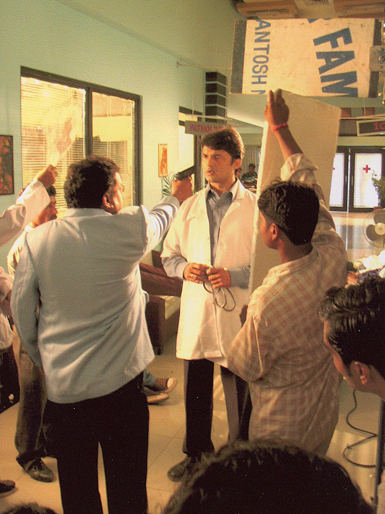
At the other end, the hospital director, victim's brother, and victim's mother wait to be filmed.
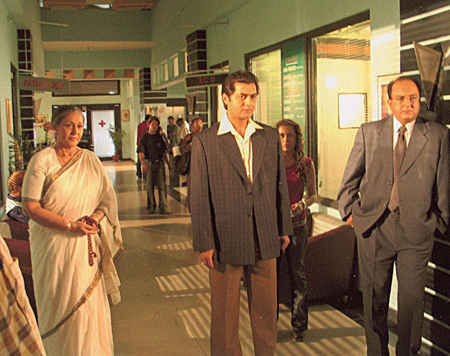
We had a delightful conversation with the lead actress "Mother" between her scenes and learned she had gotten into the industry almost by accident. Not an "A- Lister", but recognized on the street, she invited us to her home for a light meal. Sadly, we were scheduled to leave India that night, and had to pass on this opportunity.
|
